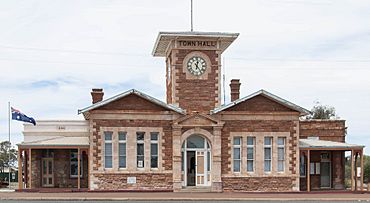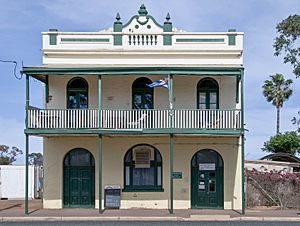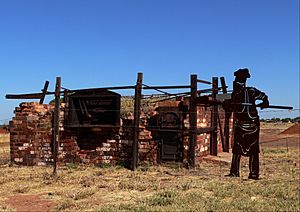Menzies, Western Australia facts for kids
Quick facts for kids MenziesWestern Australia |
|||||||||
|---|---|---|---|---|---|---|---|---|---|

Town Hall, Menzies
|
|||||||||
| Established | 1895 | ||||||||
| Postcode(s) | 6436 | ||||||||
| Elevation | 426 m (1,398 ft) | ||||||||
| Area | [convert: needs a number] | ||||||||
| Location |
|
||||||||
| LGA(s) | Shire of Menzies | ||||||||
| State electorate(s) | Kalgoorlie | ||||||||
| Federal Division(s) | O'Connor | ||||||||
|
|||||||||
Menzies is a small town in the Goldfields-Esperance region of Western Australia. It is about 728 kilometers (452 miles) east-northeast of Perth, the state capital. The city of Kalgoorlie is 133 kilometers (83 miles) to the north-northwest. In 2016, Menzies had a population of 108 people. Aboriginal people have lived in this area for a very long time.
Contents
History of Menzies
The Gold Rush Begins
In 1894, people discovered gold in the Menzies area. Leslie Robert Menzies, who was a prospector (someone who searches for gold), and John McDonald were the first to claim land there. They named their gold claim "Lady Shenton." It was a very rich gold find.
Because of this discovery, officials decided to create a town in 1895. They named the new town Menzies, after Leslie Robert Menzies. The town was officially announced in August 1895.
Growth and Development
Land in Menzies was sold in 1895. By 1896, Menzies became its own municipality, which means it had its own local government. A railway line was built from Kalgoorlie to Menzies. It opened on March 22, 1898.
By 1900, Menzies was a busy place with about 10,000 people. It had thirteen hotels and two breweries. Many mining claims were made around the town.
Water Supply and Town Hall
Getting water was a challenge. People had to bring water to the town from underground sources and nearby lakes. To help with this, the government started building a dam in 1897. This dam began supplying water to Menzies by 1901.
The town hall was finished in 1901. For over 100 years, the hall's clock tower did not have a clock. The original clock was lost when the ship RMS Orizaba sank in 1905. A new clock was finally put in place in 2000 to celebrate the new millennium.
Decline and Continued Mining
The town's success did not last long after 1901. The gold rush was mostly over in about 10 years. By 1905, most miners had left Menzies to look for gold elsewhere. By 1910, the town's population had dropped to less than 1,000 people.
Even though the big gold rush ended, gold mining still happens in and around Menzies today.
Menzies Today
Menzies has changed a lot over the years. The number of people living there is usually low, often less than 100. However, this number can change quickly when new mines open or close nearby.
The town has a hotel, a local government office (shire office), and a nursing post. There is also a small general store. This store sells many different foods, including baked meals, dairy products, fruits, and vegetables.
The local police station closed in 2007. The police officers who worked there were moved to other towns. These officers had built strong relationships with the community. They even organized community basketball games for children and young adults. They also held movie nights at their house for the kids in Menzies.
People from Menzies
Menzies is the birthplace of a few notable people:
- Sir Thomas Meagher (1902–1979): He was a surgeon and later became the Lord Mayor of Perth.
- Sir Colin Hannah (1914–1978): He was an officer in the Royal Australian Air Force (RAAF) and served as the Governor of Queensland.
- Ted Evans (1939–1981): He was a state Labor Member of the Legislative Assembly (MLA), which means he was a politician in the state government.




